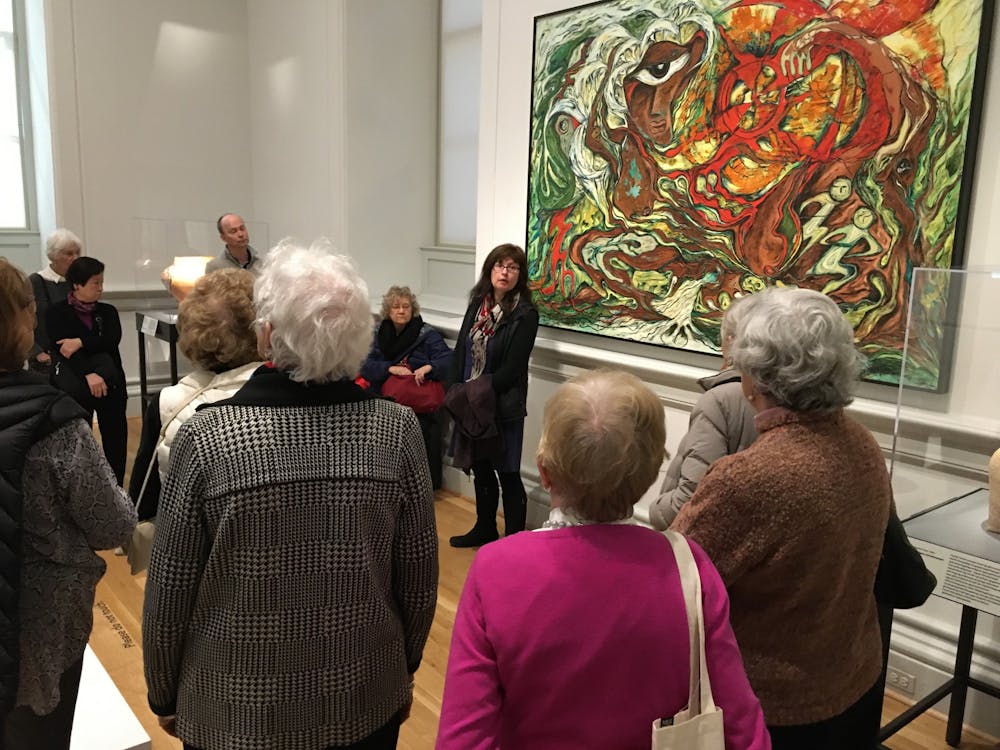The Fralin hosted a special lecture Feb. 26 by Dr. Adriana Greci Green, in which she spoke about a new exhibition focusing on the works of Native American artists called “Hearts of Our People: Native Women Artists.” The exhibition is currently being displayed in the Renwick Gallery at the Smithsonian and will be there until May 17 of this year. It was organized by Jill Alberg Yohe, a curator of Native American art at the Minneapolis Institute of Art, and Teri Greeves, a member of the Kiowa Nation and independent curator. The lecture effectively summarized how the show was created and spotlighted some of the best pieces.
Greci Green gave a wonderful presentation about both the importance of sharing this show with the public and the many ways in which it is changing how Native American art is curated. One particularly striking aspect of the exhibition is the makeup of its creative team — “Hearts of Our People” had an advisory board of 21 women, the majority of whom are Native American, and was comprised of artists, scholars and community members. The group of women arranged a comprehensive exhibition of 82 pieces of art, the dates of which span from “antiquity to the present.” The advisory board allowed for the representative perspectives of a multitude of different nations, each of which contributed to the variety of the exhibition.
It is not the norm to have a collaborative board of 21 people contributing input regarding a show, especially not 21 women. This phenomenon in the “Hearts of Our People” exhibit reflects the project’s commitment to inclusivity — Greci Green made a point to highlight the contributions of co-curator Greeves, who “opened the door” for the rest of the board to work to create the exhibition with her.
Most Native American art is made by women — though this is hardly recognized due to an assumed lack of interest in who is responsible for the production of Native American art. The minds behind the work in this exhibition are often overlooked. Greci Green mentioned in particular how Native American art is often presented as simply “tribal.” One of the most significant goals of this exhibition is to redefine Native American art as more than these oversimplified blanket terms — but instead as a rich form of expression that defies simplistic categorical and time period labels. Greci Green emphasized how colonization has taken away the identities of these Native American artists and the significance of their work, as well as how colonization continuously erases the history of Native American achievements. It has warped our view of what life was and is like for Native Americans. This exhibition gives an accurate and multi-dimensional view of the indigenous experience.
The main question posed by the exhibit was “Why do Native women create art?” In other words, what are they trying to say? In the talk, Greci Green answered this question with three categories — legacy, relationships and power. More specifically, there is an intricate history of art and symbolism passed down through families and generations, an important sense of community embedded in Native culture and Native women in leadership roles throughout the country. The questions surrounding these three ideas determined how the advisory board organized the exhibition. They used these terms to emphasize the deep meaning in every artist's work that symbolizes their values and makes them unique to their nation.
“Hearts of Our People” showcases many different types of art — including paintings, pottery, beading, hydework and clothing. The advisory board made a point to include a large variety of art and only show pieces for which they could identify the artists. Greci Green specifically discussed a dress in the show, made by Lisa Telford. Telford weaved the dress out of bark, as used to be done before the westernization of clothes. The dress is called “Pocha Haida,” which represented Telford’s sense of humor about stereotypes about indigenous women. It was designed as a response to the “Disney-fied” or fetishized version of Native American women, which is a particularly prevalent stereotype that rejects the reality of Native American women’s experiences. Lastly, Greci Green spoke about a Woman's Nomination Belt from the show. This belt represents a woman’s voice in society — used today by clan mothers to nominate the chiefs of their nation — and is an expression of female political power.
Many people’s knowledge of Native American culture stops at what they learned around Thanksgiving in elementary school. It is no secret that the history of indigenous people has always been pushed to the side in America, particularly as a result of colonization — which Greci Green emphasized that this exhibition is pushing against. The board behind this exhibition believes Native American culture needs to be understood beyond a base level, especially the contributions of women. The goal of this exhibition was to react against the anonymity of the female artists central to Native American society. This show gives a voice to those women and sends a message to all who see it of the diversity, beauty and significance of Native Americans today.
This article previously misstated Dr. Adriana Greci Green's last name as simply "Green." The article has been updated to include her full last name.







